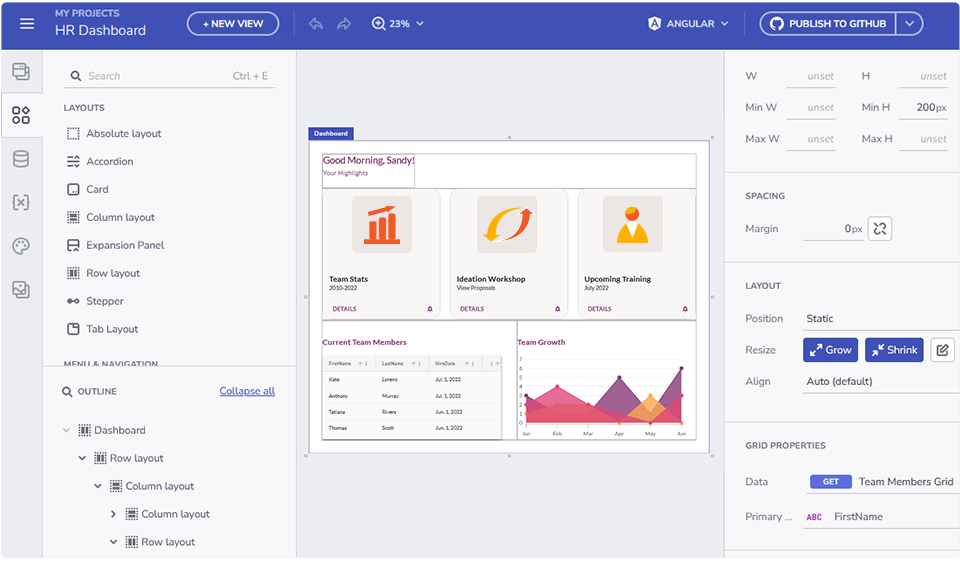

Maximizing Business Agility with Low-Code Development
Traditional software methods and outdated business strategies struggle to keep up with the fast-paced technological landscape, but a new game-changer has emerged to redefine the industry – low code. So, let’s examine how innovation tools like App Builder drive transformation and help companies achieve business agility and growth.
In an increasingly complex development environment, the ability to rapidly adapt and innovate has become a critical factor for operational efficiency and long-term success. Applications are no longer stagnant. They evolve, requiring teams to accommodate updates and respond to the ever-changing needs of end-users even after deployment. Meanwhile, Project Managers, CTOs, and other high-level executives navigate tight deadlines, shifting priorities, and resource constraints, focusing on how to maximize business agility with the right development and business strategies. All of this while enabling flexibility without sacrificing quality.
And while traditional software methods and outdated business strategies struggle to keep up, a new game-changer has emerged to redefine the landscape – low code. Low-code platforms have embraced this need for change and agile methodologies, enabling organizations to react proactively and remain competitive.
But let’s examine how innovation tools like App Builder drive transformation and help companies achieve business agility through consistent processes and stable structures.
What Is Business Agility?
At its core, business agility is about fostering company traits like adaptability, better workforce management practices, and innovation. An agile business is not just one that replaces the traditional Waterfall approach with Agile software development. It goes beyond the technical aspects to explore how the entire organization can respond to dynamic market conditions, customer demands, internal challenges, and changing processes. It’s a paradigm shift in management.
Yes, as part of the agile transformation, organizational silos do break down. The key point is that the focus shifts to creating a holistic approach that integrates every aspect of the business. This involves aligning strategies across departments, boosting productivity, improving communication, and ensuring that all teams share a common goal.
Why Agility Is Important In Business
According to the McKinsey Global Survey, “highly successful agile transformations typically delivered around 30% gains in efficiency, customer satisfaction, employee engagement, and operational performance; made the organization five to ten times faster; and turbocharged innovation.” The survey involved 2,190 respondents from different industries and geographies. Their organizations were split into two broad groups: the first consisted of organizations with no agile transformation efforts; the second group included organizations that either aimed at or had already established agile transformation.
Business agility, then, reshapes the company to compete and deliver real business impact. This extends to the flexibility to:
- Introduce and leverage new products or services: That will improve how people innovate, build, operate, and strategize in general, so there’s no pressure when teams have to deliver solutions quickly, for example, or when executives need to align business goals and technical implementations.
- Reconfigure processes at a rapid pace: This will help organizations to have intact operational excellence and eliminate things like technical debt that hampers long-term scalability, maintainability, and extensibility, as developers must dedicate time and effort to address accumulated debt and prevent future issues. In essence, agility will optimize resources by aligning them with shifting priorities.
- Maintain competitive advantage:The inability to adapt to market changes can result in losing the competitive edge, whereas companies that are more agile and responsive to market dynamics can compete more, produce more, and deliver more value. This is critical when you want to capture market share, customer mindshare, and revenue opportunities because agility pays off in competitive advantage.
How To Maximize Business Agility With Low Code?

Business agility, the hallmark of a forward-thinking organization, can be significantly enhanced using low-code platforms like App Builder. It basically provides a user-friendly environment where both technical and non-technical users can collaborate to build applications quickly and establish better operational efficiency in the company in general. Let’s look at this closer.
Faster time to market
Low-code platforms provide a WYSIWYG visual development interface featuring a library of pre-built UI components for major frameworks, templates, and layouts that users can leverage to accelerate development. So, when it comes to development teams, they can easily utilize reusable building blocks with every functionality they need functionalities, such as user authentication, data management, and UI elements, to assemble applications at a fraction of the time. By speeding up the development process, organizations are empowered to achieve faster time to market and achieve quicker product launches, which can significantly enhance revenue potential. For a CTO, this means a faster ROI and the ability to capitalize on additional market opportunities.
Scalability, adaptability to industry dynamics, and performance
According to the Gartner CEO Survey, enterprise priorities vary, with the most common ones being growth, technology-related, workforce, and others. How do low-code tools and business agility fit in here? From a more practical perspective, low-code platforms are built on scalable architectures that accommodate both business and app growth over time, helping companies adapt to market changes. These architectures typically leverage cloud infrastructure and microservices-based designs to enable horizontal and vertical scaling. This ensures the company can efficiently manage increased user demands, deploy new features faster, and pivot their strategies accordingly.
The search for high-performance teams
Low-code platforms offer intuitive, drag-and-drop visual development interfaces that enable even developers with little technical expertise to design apps and user interfaces quickly without extensive hand-coding. They can start from a sample app and customize it further or convert Sketch/Figma design files to production-ready code in the framework of their choice thanks to the instant Code Generation low-code capabilities. Moreover, these platforms also provide real-time preview and feedback capabilities that allow users to visualize and interact with their applications as they build them. Because app development here is democratized, everyone (from developers to stakeholders) can preview changes instantly, test functionality, exchange feedback, and enable rapid iteration and refinement of designs and features. So, agility here is taken to the next level.
Cost saving
Low code allows executives to allocate technical resources more efficiently by reducing reliance on highly specialized developers. This means teams can accomplish more with fewer resources, and skilled developers can focus on more complex tasks and high-impact projects. On the other hand, citizen developers can tackle more straightforward and repetitive tasks.
Increased relevance
Market changes often reflect shifts in customer preferences, technology trends, or regulatory requirements. So, if your teams fail to adapt, they risk becoming irrelevant in the eyes of customers, stakeholders, and industry peers, undermining their credibility and long-term viability However, when you have an agile strategy in place, teams can experiment with new and more relevant ideas without excessive risk. Especially when you use low-code tools for task automation and productivity boost.
How To Overcome Common Challenges With Low-Code Adoption?
I’ve summarized this in five crucial steps:
Step 1: Skill gaps assessment: You will have to start by evaluating the current skill expertise of your development teams. Once you’ve identified the gaps, assign proper training programs.
Step 2: Ensuring seamless integration with existing systems: Check requirements, plan integration in advance, choose platforms that are easy to integrate, and dedicate time to testing procedures.
Step 3: Security and compliance concerns: For this purpose, conduct regular security assessments of the low-code tool for potential vulnerabilities. Also, stay up to date with the latest regulatory requirements.
Step 4: Scalability and performance issues: Research how well the tool can handle scalability so the solutions and the goals of the company can grow according to the market dynamics and customers’ needs.
Step 5: Equip and enable everyone: The decision to launch new processes and introduce new tools is strengthened by the question “Why.” That’s why executives should clearly communicate the transition’s benefits to everyone using the platform.
The Future of Business Agility with Low Code
Business agility has transitioned from theory to practice for the last few years. More and more companies are seeing its benefits because it’s a proven way to improve performance and gain a competitive edge.
For those not repurposing any efforts to business agility, it’s essential to reassess the strategies in place. Companies may need to explore low-code development platforms to facilitate faster application development and promote collaboration across teams. By integrating low code into their business agility initiatives, organizations can break down silos and empower non-technical users to contribute to solutions, thus fostering a more agile and productive culture.
For those who have initiated business agility practices or are near it, integrating low-code platforms like App Builder will further amplify their efforts. Gartner estimates that “by 2025, 70% of new applications developed by organizations will use low-code or no-code technologies, up from less than 25% in 2020.” And as organizations continue to navigate their agility journeys, low-code development will be instrumental in shaping the future. By adopting these platforms, CIOs and executives can unlock new operational efficiency, innovation, and productivity levels, ensuring their organizations remain competitive in an environment that demands rapid changes and fast adaptability.


